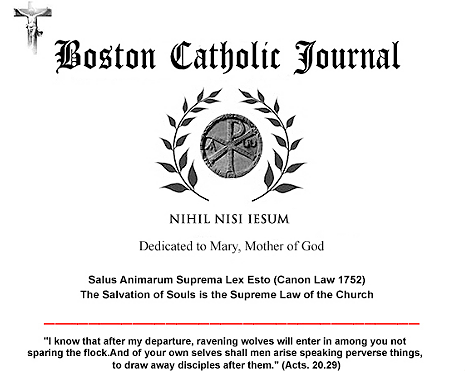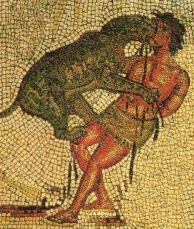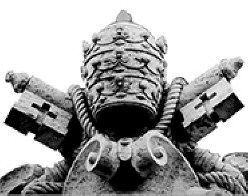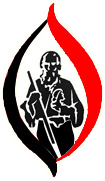|

The Tortures and Torments
of the Christian Martyrs
from
De SS. Martyrum
Cruciatibus
(a Modern Edition)
Chapter II
Of the Wheel, the Pulley, and the Press,
as Instruments of Torture
We
now come to other instruments of
torture applied to the Holy Martyrs apart from the various types of
hanging, both on Cross and Stake discussed in the
previous chapter. However, since the instruments named above, together
with the Wooden Horse, are without doubt the most terrible and
appalling of all, we will look at them now — and the Horse in
the following chapter. Concerning the torture of the Wheel, which is
widely held to be the severest of all, it is significant to note its
antiquity. This form of torment was first practiced earlier by the Greeks.
We learn this from numerous statements made by their own writers and
preserved among us. Aristophanes in the Plutus says:
“By rights you should
be bound to the Wheel, and so forced to reveal your evil doings.”
Commenting on this same
passage, one ancient commentator adds:
“The Wheel was
a contrivance on which slaves were bound down for punishment.”
Again the same poet, in
his Lysistrata states:
“For sorrow! What
a convulsion and a straining of every limb do I feel, for all the
world as though I were being racked on the Wheel!”
Anacreon, as quoted by
Athenceus, speaks of the same thing, when he says,
“Many torments and
rackings of the neck I endured on the Wooden Horse, and many on
the Wheel.”
Similarly Demosthenes
in his Oration against Aphobus says:
“Let us set Milias
on the Wheel to be tortured”
And Plutarch, in his
Nicias:
“Then he proceeded
to bind the barber to the Wheel, and further torture him.”
Also, Lucian in the
Epistle to Stesichorus writes:
“After being lopped
of their extremities, they were racked and stretched on Wheels;”
And Suidas in his Dictionary
under the word Wheel describes it thus:
“The Wheel was an
instrument of torture for racking men’s bodies. Whence Aristophanes:
’Let him be torn on the wheel and flogged.’ So slaves were bound
to the Wheel and thrashed. And in another passage: ’You will have
to speak up on the Wheel and confess your crimes.’ Thus we see people
were tortured on the Wheel and questioned to discover their complicity
with others and their own wrong doings. Similarly the Wheel was
an apparatus of wood, on which slaves were bound for punishment.”
Phalaris seems to give
concurrent testimony in one of his Epistles, where we read:
“They were being tortured,
or racked, on the Wheels.”
The device is alternately
spoken of by Pindar, Homer (both in the Iliad and the Odyssey),
Lucian, Ovid, Propertius, Seneca, and Claudian.
Other ancient authors also make mention of the torture of the Wheel,
especially Josephus in discussing the Maccabees in the
Jewish War
[Bellum Judaicum]:
“Some refused to eat
of polluted meats; these he ordered to be tortured on the Wheel,
and put to death;“ and again: “For this make ready the wheels, and
blow up the fire to a fiercer heat.“ And further on: “But when the
Apparitors [constables] had set ready the Wheels and Cords, the
Tyrant adds ...“; and again, “The Apparitors were then directed
to bring in the elder prisoner; and tearing away his tunic, bound
him hand and foot with thongs every way. And when those who applied
the lash were wearied out without gaining anything, they fixed him
about a great Wheel, stretched around the circumference of which
the noble-hearted youth had all his joints dislocated and all his
limbs broken.“ And a little further on: ’“Wicked hirelings,’ cried
the youth, ’your Wheel is no more able than you to drown my reason;
cut off my limbs, and burn my flesh, and rack my joints with the
twisters’ On his so saying, they set fire underneath, and divided
him limb from limb, stretching his body over the Wheel. And the
whole Wheel was stained with his blood, and the grate, which contained
the pile of coals, was put out by reason of the drops of blood pouring
down upon it, while about the axles of the wheel the gobbets of
flesh were carried round and round, the parts adjoining the joints
of the bones being everywhere cut to pieces. Nevertheless the noble
youth Abraham never uttered so much as a groan, but nobly
endured the twisters, that is the instruments of torment.”
He reiterates this later:
“They proceeded to
disarticulate Arthremboles’ hands and feet at the joints, and separating
these from the ligaments, tore them away with levers and so perforated
his fingers, arms, legs and elbows. But when they found that they
could not break his resolution, they dragged off the skin together
with the tips of the fingers, and immediately led him to the Wheel,
about which were crushed the joints of every limb, and he saw his
own flesh cut to pieces and drops of blood distilled from his inwards.”
Also yet again:
“The Apparitors dragged
him bound to the catapults to which, when they had tied him at the
knees, and secured them firmly with iron bands, they bent back his
loins over a rounded wedge, so that all his body being dashed around
its circumference, was broken in pieces.“ And further down: “They
fastened him to the Wheel, on which he was stretched and burned
with fire; moreover they applied spits, sharpened and made red-hot,
to his back, and pierced his sides and inwards.”
Other writers speak of
the Wheel, for we find in Apuleius’, Golden Ass [also known as
The Metamorphoses]:
“Without an instant’s
delay, according to the Greek custom, fire and wheel and every kind
of torture were exhibited”
And again,
“Neither the Wheel
nor the Horse, after the manner of the Greeks, were lacking to his
instruments of torment.”
Cicero in the Tusculan
Orations, says,
“Thus much we are
justified in saying, that the happy life cannot end on the Wheel.”
In Virgil’s, Aeneid,
6 we find:
“And there they hang,
stretched out on the spokes of wheels.”
The 4th century
biographer Julius Capitolinus also states:
“The Tribune of the
Soldiers who allowed his post to be abandoned was tied beneath a
wheeled wagon and so they dragged him, alive and dead, the whole
stage.”
St. Basil, too, in his,
Homiles on 40 Martyrs, writes:
“Fire moreover was
made ready, the sword unsheathed, the cross set up, the sack, the
wheel, the scourge prepared;“ and in his Homily on St. Gordius
the Centurion: “Let his body be torn on the Wheel.”
St. Gregory of Nazianzen
and Nicephorus equally makes reference to these Wheels, as well as many
Lives of the Saints, especially in the case of St. Catherine,
St. Euphemia, Virgin and Martyr, and St. Felix and his companions.
These Wheels —
as we have gathered from the Histories of different Martyrs —
were not of one kind only, but of several. Some, which we find spoken
of as Machines in the Acts of the Saints, were broad and
large, while others were narrow. We will discuss both.
The Wheel of the first sort, that is to say, the larger Wheel of which
Nicephorus and the Acts of St. Pantaleemon speak, was made in
such a way that being taken up to some high hill, with the victim bound
to its circumference, the Wheel, together with the condemned man, was
then violently hurled down from the summit of the mountain by a steep
and slippery way, so that each member of the Martyr’s body was broken.
Thus do we read of that most glorious servant of Christ, Pantaleemon,
in the History of his Martyrdom:
“And they said to
him, ’Let the great wheel be brought, and carried to the top of
the mountain, and have him bound to it and hurled down the mountain
in such a way that his flesh may be miserably scattered abroad,
and he die.’ The most blessed Pantaleemon was then led away to prison
while the wheel was being constructed. As soon as it was finished,
the Judge ordered the criers to proclaim through the city, that
all men should come together to see the death of the Blessed Pantaleemon,
and ordered him to be brought in. When the holy Martyr of Christ
was led in, to their amazement he was singing Psalms to the Lord
in Christ! Then the Attendants bound him over the wheel; but as
soon as they began to roll the wheel, his bonds were loosed, and
the Holy Martyr stood up unhurt. The wheel, however, rolling onward,
killed many of the Heathen.”
Other types of broad wheels
were also used by the Heathen for the massacring of Christians. The
circumference of these wheels, to the which the naked Martyrs were bound
by cords, was imbedded with blades, sharp nails, and the like, and then
suspended stationary in the air. Then revolving the martyrs along with
the wheels again and again with all their might over iron spikes fixed
in the earth for piercing and cutting, they caused the flesh of the
sufferers thus punished to be dreadfully torn and mangled. It was precisely
by such a torture wheel that we suppose the Blessed Virgin of Jesus
Christ, St. Catherine, to have won the Crown of Martyrdom, to which
her Acts in part witness.
Of Wheels of the Second Sort
Other wheels of a lesser
breadth than those just described were likewise used by these Devil-worshippers
for torturing faithful Christians. Around the circumference of these
wheels they would very often fix sharp nails and the like, in such a
way that their points, being turned upward, might project beyond the
rims. Then on the wheels thus arranged they would bind the Martyrs whose
bodies were then pitifully torn by the sharp points of the spikes, as
well as by others which stood planted in the earth beneath. In the
Acts of St. George we find the following narrated:
“The Emperor ordered
a wheel to be brought in stuck all round with sharp points, and
the Saint to be bound naked to it, and so mangled by the various
devices imbedded within it. The wheel was hung in the air, while
underneath planks were laid upon which were closely fixed together
a number of spikes, like sharp swords, some with their points straight
upward, others curved like hooks, while still others resembled flaying
knives. When the revolving wheel approached the planks — and the
Holy Man bound like a lamb to it with slender lines and small cords
in such a way that they cut into into his flesh and were imbedded
within it — it was forced, as the wheel turned, to pass over the
swords, and the Martyr’s body was caught on their keen edges and
terribly lacerated, contorted, and torn in pieces as if with the
instrument known as a “scorpion.”
It is next to be specially
noted that the Heathen, after binding the Martyrs to wheels, thrashed
them cruelly with rods and cudgels as they were whirled round upon it.
The Acts of St. Clement of Ancyra give testimony in the following
terms:
“The Magistrate ordered
the Martyr (that is, Clement) to be bound to the wheel, and the
latter to be revolved at great speed with the Martyr upon it being
simultaneously beaten savagely with rods. Immediately the Martyr
was bound to the wheel, and the wheel turned rapidly. Now the Martyr,
while he was on top of the wheel in its revolution, was exposed
to the fellows who stood ready with their rods; but when the wheel
carried him underneath, his body was bitterly crushed and
his bones broken.”
Nevertheless, the Heathen
were not content in venting their hatred for our fellow-Christians through
these means of torture alone, that is to say, through which they bound
the Martyrs to wheels and tormented them, for they never ceased to invent
new ones. Hence it came about sometimes that, binding them to wheels
having sharp spikes fixed all round, and placed over a fire burning
below, they would revolve the wheel, together with the Martyr, round
and round and round at high speed. In other words, in just the same
fashion as meat placed upon a spit and set to the fire be roasted and
cooked, so were the Martyrs turned about and roasted, that they might
become fine bread of Jesus Christ. In the Acts of St. Christina,
Virgin and Martyr, and of St. Calliopius, we find it written: “Set up
the wheel”, he (the Prefect) said to his Apparitors, “and kindle a great
fire beneath it,” upon which the youth was tightly bound to the wheel
and was racked to pieces. Then instantly an Angel of God approached,
and put out the flame of the coals; and when the attendants tried to
turn the wheel, they could not. But his tender limbs bespattered all
the wheel with blood, for it was armed all around with sharp swords.“
In this way, the Blessed Martyrs, bound to wheels, and revolved upon
them over a fire, happily won the most noble Crown of Martyrdom.”
Moreover it was the custom with these same impious men to use the several
interstices of the wheels, of the narrow sort described above, in such
a way that the limbs of Christ’s faithful servants, after being first
broken with iron bars, were intertwined and inserted within them so
that they appeared, as it were, woven in with the spokes. Then attaching
the wheels to the upper end of poles set upright in the ground, they
would leave them in this condition to live on for days. This torture,
as mentioned by Gregory of Tours in his History of the Franks,
was inflicted at Valence in Gaul upon Felix, a Priest, and Fortunatus
and Achilleus, Deacons, who had been sent to Tour by St. Irenaeus, Bishop
of Lyons, to preach the word of God.
We have already seen that the wheels which were used for stretching
and racking the bodies of Christians, were either pulleys or
the wooden horse — for by means of these instruments, which contained
several small wheels, and so could be collectively spoken of as wheels,
were the bodies of Christ’s faithful servants especially torn — or else
in no way differed from the wheels just described, as the History
of St. Calliopius quoted above seems clearly to imply, for it states
that he was so tightly bound to the wheel with small cords, that even
before his tormentors began to revolve it, the blessed youth was mangled
and torn to pieces.
Of Pulleys
Pulleys, as instruments
of martyrdom, are spoken of by Eusebius in his Ecclesiastical History
and in many Acts of the Saints, especially those of Saints Crispinus
and Crispianus, and of St. Quintinus, a Roman citizen. Further mention
is made of them by Gregory of Tours who, in his History of the Franks,
says:
“Stretched at
the pulleys, he was beaten with cudgels, rods, and double thongs“;
and in another place, “He was stretched on the ground
at the pulleys, and finally beaten with triple thongs;“ and
still further that, “The King was furious and ordered them to
be stretched at the pulleys, and violently beaten ...”
A careful study of these
sources will show beyond a doubt that this sort of punishment was especially
employed to torture criminals and murderers. It is no surprise, then,
atht the true worshippers of God, fighting for His honor, were racked
or drawn aloft by means of pulleys at the hands of the Heathen who,
after all, accounted Christians among the most criminal of all mankind.
Pulleys — what were they?
The Pulley (as is clear
from Vitruvius) was a contrivance for hauling, provided with a roller
or little grooved wheel, moving on a small axle, with the pulling rope
being led over it. It was used either for hoisting weights to a height
and into the required positions in building, or for lowering them, or
else for moving things, and lastly for drawing water from wells. Pulleys
(see Isidore, Etymologicum) may be best described as made in
the likeness of the theta, or eighth letter of the Greek alphabet [Θ]
and named trockleae from the word trochla, signifying
a little wheel. Some modern writers, then, err who hold the trocklea
(pulley) to have been simply a capstan or windlass.
Granted that a pulley
is incapable of tearing asunder the bodies of condemned criminals without
the addition of some accompanying instrument to help, whether a stake
to connect it with, or some device of one sort or another; yet must
it not be concluded from this that it was a capstan, but only that it
required a capstan of some kind. Inasmuch as in this form of torture
the bodies of the victims were often horribly stretched and racked,
it appears to us certain — especially when we consider the difficulty
of tearing a man’s body apart, and at the same time consider the
relatively little effort exerted by the executioners — that some
small engine was employed in conjunction with the pulley, such as a
capstan or the like. If one reads the passages of Vitruvius referring
to this subject, it will become apparent that the pulley was not
a capstan, nor yet the capstan a pulley. Lastly, we should note
that in the accompanying Fig. IX a capstan is illustrated along with
a pulley, not to imply these were one and the same, but to show the
probability that the victims, for the reason just alluded to, were torn
and racked by both these instruments at once. We say “probability”
because there are other ways in which it could be done, and very likely
sometimes was.
Now the way in which Christians were tortured by the pulley is as follows.
First of all, as many stakes were fixed in the earth as there were victims
to be punished. This done, the appointed attendants proceeded to bind
the Martyrs, sometimes by their hands, sometimes by their feet, to the
ropes of the pulleys one way and to the stakes the other; then the ropes
being pulled tight according to the Judges’ orders, their bodies were
miserably stretched and racked. All this is shown in the Acts
of the sons of St. Symphorosa the Martyr, as well as by Gregory of Tours,
in his History of the Franks.
Those condemned to this
punishment (as we see from the History of the Martyrs, St. Quintinus
and St. Ferutius, and other passages in Gregory of Tours already noted)
were, at the same time , both racked at the pulleys and simultaneously
beaten with cudgels or burned with torches — or else sprinkled with
red-hot sulfur, resin, boiling oil, and the like. Thus in the Acts
of the Blessed Quintinus we find:
“Then the Prefect,
raging with despotic fury, ordered the holy Quintinus to be so cruelly
racked at the pulleys that his limbs were forced to part at the
joints from sheer violence. Moreover, he commanded him to be beaten
with small cords, and boiling oil and pitch and melted fat to be
poured over his back, so that no kind of punishment and torment
available may fail to contribute to his agony. When this yielded
nothing the savage Prefect Rictiovarus, to glut his mad and monstrous
thirst for cruelty, further ordered burning brands to be applied.”
Martyrs Hoisted up with Pulleys
Lastly we must consider
that the Christian martyrs were not only stretched and racked
with pulleys, but were also hoisted aloft by them in the same
manner by which condemned criminals at that time, with hands tied behind
their backs, were hauled up in the air by a rope in order to extort
the truth from them. This kind of torment is said to have been used
with the holy Martyr of Christ, St. Servus, of whom we read in the
Roman Martyrology on December 7th:
“At Tuburbo in Africa,
anniversary of the Martyr, St. Servus, who in the Vandal Persecution
under the Arian heretic King Hunneric, was a long time beaten with
clubs, then repeatedly hoisted aloft with pulleys, and suddenly
let go with the the full weight of his body onto flint stones. Thus
scarified by the sharp stones he won the palm of martyrdom.”
Further details concerning
the same Martyr can be found in Victor’s, The Vandal Persecution.
Of the Press as an Instrument of Torture
The Christian Martyrs
were also squeezed in Presses, much in the way that grapes and olives
are pressed to extract wine and oil. It was by this method of torture
that most noble soldier of Christ, St. Jonas, was martyred, of whom
we read in the Acts of this Martyr:
“They (the Persian
Magi) ordered the Press to be brought and St. Jonas to be placed
within it, and violently pressed and cut to pieces. The Attendants
did as they were commanded, and squeezed him mercilessly in the
Press, breaking all his bones, and finally cut him in two through
the middle.”
Illustrations
for Chapter II:
click to enlarge
CHAPTER III
Chapters:
1 -
2 -
3 -
4 -
5 -
6 -
7 -
8 -
9 -
10 -
11 -
12

Totally Faithful to the Sacred
Deposit of Faith entrusted to the Holy See in Rome
“Scio
opera tua ... quia modicum habes virtutem, et servasti verbum
Meum, nec non negasti Nomen Meum”
“I
know your works ... that you have but little power, and
yet you have kept My word, and have not denied My Name.”
(Apocalypse
3.8)
Copyright © 2004
- 2025 Boston Catholic Journal. All rights reserved. Unless
otherwise stated, permission is granted by the Boston Catholic
Journal for the copying and distribution of the articles
and audio files under the following conditions: No
additions, deletions, or changes are to be made to the text
or audio files in any way, and the copies may not be sold
for a profit. In the reproduction, in any format of any
image, graphic, text, or audio file, attribution must be
given to the Boston Catholic Journal.
|
|


























